Abstract
The Virunga Volcanic Province (VVP), located in the western branch of the East African Rift System, hosts a variety of alkaline lavas erupted from closely spaced volcanic centers. However, the magmatic system of this region, particularly in its eastern sector, remains insufficiently constrained. In this study, we present a petrological and geochemical investigation of basaltic to trachytic lavas from the eastern VVP. Thermobarometric analysis of mineral phases indicates that basalts originated from magma storage zones between 4 and 30 km deep, with crystallization temperatures of ~1200 °C and melt H2O contents lower than 1 wt%. In contrast, more evolved magmas crystallized at similar depths, but at lower temperatures (~1050 °C) and higher H2O contents, ranging from 2 to 4 wt%. Thermodynamic modelling suggests that extensive (up to 70%) fractional crystallization of an assemblage dominated by olivine, clinopyroxene, and plagioclase can produce the more evolved trachytic derivatives from basaltic parental melts. When integrated with previous studies from other VVP volcanoes, our findings deepen the understanding of the architecture of the magmatic system beneath the region, suggesting it resembles a well-developed multi-level plumbing system.
1. Introduction
Understanding magma transport and storage conditions in volcanic plumbing systems is challenging due to the intrinsic complexity of these latter, which are made of a network of interconnected storage zones evolving over time [1,2,3]. The study of the eruptive products and their hosted minerals may provide key information into the depths and composition of subvolcanic magma storage zones, helping to clarify magma differentiation scenarios. Indeed, the chemical composition of minerals hosted in volcanic rocks can be used as input for thermobarometers [4,5] and thermodynamic models [6,7], or in combination with textural information to retrieve information on magmatic processes such as cooling, fractionation, ascent, convection, and degassing (e.g., [8,9,10]).
In this study, we investigate the P-T-fO2-H2O conditions of magmas residing in the plumbing system beneath the eastern portion of the Virunga Volcanic Province (VVP), a narrow volcanic area within the western branch of the East African Rift System (Figure 1). The VVP is known for hosting the active Nyiragongo and Nyamulagira volcanic complexes [11,12]. Overall, the volcanic centers of the VVP erupted a variety of alkaline magmas ranging from silica-undersaturated to more silica-rich compositions ([13] and references therein). The silica-undersaturated volcanic products exhibit marked geochemical variations, even at closely spaced volcanic centers, due to complex lithosphere-asthenosphere mantle interactions as well as changes in the melting conditions [13,14,15,16,17,18,19,20]. Instead, except for the active Nyiragongo and Nyamulagira volcanoes, the processes controlling the magmatic evolution documented by VVP volcanic products remain largely unexplored [1,12].
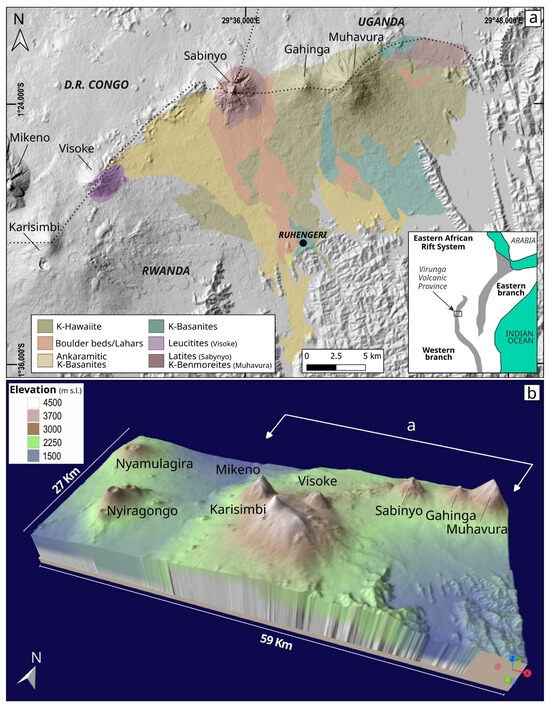
Figure 1.
(a) Shaded relief of the central-eastern Virunga Volcanic Province (VVP) with the distribution of geological formations derived from the georeferenced geological map (modified from [21]). (b) Three-dimensional view showing the main volcanic edifices of the VVP based on the 30m SRTM DEM (Shuttle Radar Topographic Mission Digital Elevation Model) from QGIS 3.28. The location of (a) is indicated with a white line.
Differentiated volcanic products up to trachyte in composition occur at the eastern portion of the VVP region (Figure 1). The genesis of these products is mainly attributed to prolonged fractional crystallization of basic magmas with a minor role for assimilation of the local crustal lithologies [21]. No constraints on the magma storage zones are available for this region. This work aims to improve knowledge on the plumbing system beneath this region, providing information on the magma storage zones related to a set of lava samples that exhibit geochemical features representative of primitive to evolved compositions found in the eastern VVP, and which are documented by the existing petrological dataset ([13] and references therein). Our approach integrates mineral compositions and whole rock geochemistry to provide insights into plausible physico-chemical conditions related to magma differentiation processes in the region. First, we determined the pre-eruptive crystallization conditions of the studied lava samples combining petrographic information and thermobarometric calculations. Then, we performed thermodynamic simulations to model the melt evolution recorded by all the rock data. Finally, we compared our results with those recently obtained for the active Nyiragongo and Nyamulagira volcanoes of the VVP [11,12], finding analogies that indicate control by a trans-crustal plumbing system in the magmatic evolution of the VVP lava suite.
2. Geological and Petrological Background
The VVP is a ~3000 km2 area located at the junction of Rwanda, Uganda, and the Democratic Republic of the Congo (Figure 1). Its formation is related to the onset of the extensional regime and rifting phases along the Tanzania-Congo craton ([16] and references therein). Volcanism in the region began 12 Ma ago, although the major volcanic edifices and smaller volcanic cones formed during the last 300 Ka ([13] and references therein). From east to west, the main volcanic edifices are: Muhavura, Gahinga, Sabinyo, Visoke, Karisimbi, Mikeno, Nyiragongo, and Nyamulagira (also known as Nyamuragira) volcanoes (Figure 1).
Two magmatic suites can be identified by looking at the geochemical dataset currently available for the VVP volcanic products ([15] and references therein): one includes leucite- and melilite-nephelinites, plus nepheline-leucitites found at Nyiragongo, Mikeno, and Visoke volcanoes; the other refers to leucite basanites and more SiO2-rich compositions (up to trachytes) occurring at Nyamulagira, Karisimbi, Visoke, Sabinyo, Gahinga and Muhavura volcanoes.
Several petrological studies on VVP magmatism have been devoted to the understanding of the mantle source of the magmas. Most of these studies agree that a variably metasomatized cratonic lithospheric mantle is an important source for generating the compositional diversity observed in the most primitive magmas erupted at the VVP (e.g., [15,16,18,19,21]). However, ref. [14] proposed that a heterogeneous mantle plume source could explain such compositional variability of magmas. Nonetheless, as pointed out by [16], there is no unequivocal evidence for the presence of a mantle plume beneath this portion of the East African Rift System. Few studies provide insight into the magma differentiation process that occurred at the VVP, only referring to the active Nyiragongo and Nyamulagira volcanoes located at the easter portion of this volcanic province [11,12]. According to these studies, magma differentiation beneath the western VVP is linked to interconnected magma storage zones distributed along the plumbing system, where fractional crystallization, crystal accumulation, and magma mixing/homogenization processes occurred. Magma differentiation is still poorly explored at eastern VVP volcanoes. The geochemical features of the basanites to trachytes evolutionary suite found at these volcanoes indicate a major role for protracted fractional crystallization processes of primitive magmas with, locally, a minor role for crustal interaction processes [20,21,22].
3. Sampling and Analytical Methods
The lava samples investigated in this work are random blocks collected near the village of Ruhengeri, in the eastern VVP (Figure 1). The samples were not collected in situ due to the complex government regulations in this part of the VVP, which has hindered the sampling efforts. With the Ruhengeri village being very close to the Sabinyo, Gahinga, and Muhavura volcanoes (Figure 1), we suggest that the collected samples derive from eruptive products of these volcanoes. As illustrated below, the comparison between the whole-rock and mineral analyses of the investigated samples with the limited amount of previously published data on these volcanoes [18,21] reveals strong similarities, thus supporting our suggestion.
Geochemical and Mineral Chemistry Analysis
Quantitative chemical analyses of selected minerals were performed using a Jeol 8200 Superprobe electron probe micro-analyzer at the Dipartimento di Scienze della Terra of the University of Pisa (Italy). The following analytical conditions were used: wavelength dispersive spectrometry mode, accelerating voltage of 15 kV, beam current of 20 nA, electron probe diameter of 3 µm. The following standards and X-ray lines were used: diopside (MgKα, SiKα, CaKα), albite (NaKα, AlKα), sanidine (KKα), almandine (FeKα), rhodonite (MnKα), rutile (TiKα), Cr2O3 (CrKα), apatite (PKα, FKα), and barite (BaLα). Peak counting times were 20 s (30 s for Na) and half of the peak time for each background. Matrix correction using the φ(ρz) procedure [23] was applied to the measured data. The detection limits are: 0.01 wt% for MgO, Al2O3, K2O, CaO, MnO, and FeO; 0.02 wt% for TiO2, Cr2O3, and NiO; and 0.03 wt% for Na2O and SiO2. All the compositional data are reported in Tables S1–S6, and secondary standard analyses are reported in Table S8.
Whole-rock major and trace elements were determined for the studied rock samples at Activation Laboratories (Hamilton, ON, Canada) according to the 4-LITHORES code. Samples were ground in a low-blank agate mill. The powdered samples were fused with a lithium metaborate–tetraborate mixture, and the resulting glass beads were fully dissolved in 5% HNO3. Major oxides were analyzed using a Varian Vista 735 ICP-AES, while trace elements were measured with a Perkin Elmer Sciex ELAN 9000 ICP-MS (both Agilent and Perkin Elmer companies have their headquarters based in Santa Clara, CA, USA). More information about the analytical methods and the precision and accuracy of the data can be found at www.actlabs.com. The whole dataset, including analytical precision and accuracy, is reported in Table S1 (QC).
4. Results
4.1. Classification and Petrography of the Studied Samples
The petrographic inspection of the five lava samples analyzed in this study (i.e., C4, C9, R1, R3, R6) did not reveal evidence of secondary alteration products. This observation is supported by the low Loss on Ignition (LOI) values (0.15–1.4 wt%) (Table S1). All the samples are potassic (K2O/Na2O = 1.3–1.4 wt%; K2O = 2.6–5.6 wt%), and according to their position on the Total Alkali-Silica (TAS) diagram (Figure 2), they can be termed basalts (C4 and C9 samples), basaltic trachyandesite (R3 sample), and trachyandesites (R1 and R6 samples).
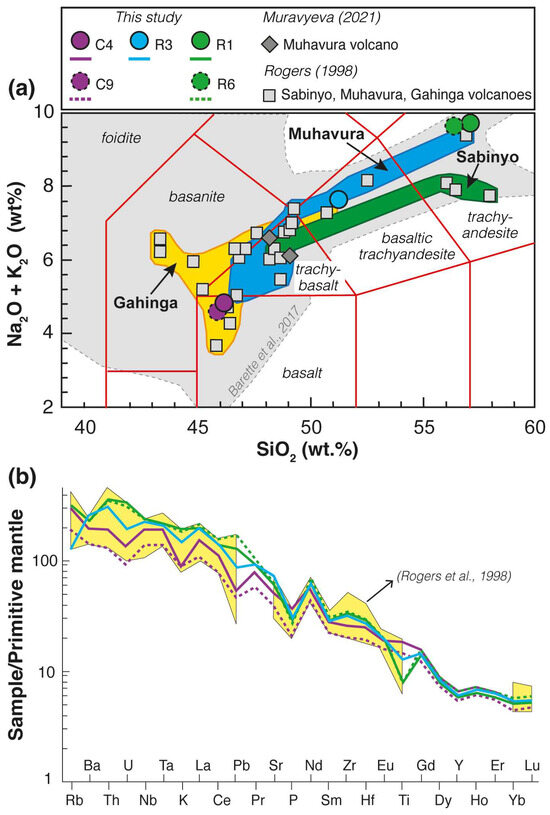
Figure 2.
(a) Total alkalis versus silica (TAS) diagram after [24] and (b) primitive mantle normalized multi-element diagram (primitive mantle normalizing values from [25] for the lava samples from the eastern Virunga Volcanic Province analyzed in this study). Colored fields in (a): grey field refers to the compilation of VVP lavas [13]; green, yellow, and blue fields envelop the data from the literature available for lava from the Sabinyo, Muhavura, and Gahinga volcanoes [18,21]. The yellow field in (b) envelops the literature data available for lava from the Sabinyo, Muhavura and Gahinga volcanoes [21].
4.1.1. Petrographic Feature
All these samples have a porphyritic texture (at place glomeroporphyritic), with vesicles varying from subspherical to elongated (Figure 3). The phenocryst content is higher in the two basaltic lava samples (15 and 35 area% in samples C4 and C9, respectively) and in the R3 basaltic trachyandesite (20 area%) than in the two andesitic lava samples (5 and 10 area% in samples R6 and R1, respectively).
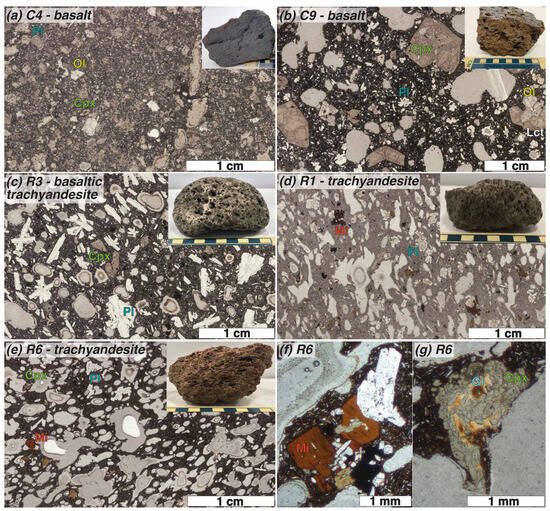
Figure 3.
Low-magnification thin-section images showing the textures and petrographic features of the investigated lava samples. The images are reported following the whole-rock chemical evolution inferred from the TAS diagram of Figure 2: (a) C4 and (b) C9 basalts; (c) R3 basaltic trachyandesite; (d) R1 and (e–g) R6 trachyandesites. Hand sample view is shown at the top-right of each image. Gl = glass, Ol = olivine, Cpx = clinopyroxene, Pl = plagioclase, Lct = leucite, Mica = Mi.
Olivine and clinopyroxene are present in the phenocryst assemblage of both C4 and C9 basalts, with clinopyroxene crystals in C9 basalt reaching a maximum axis of up to 1 cm (Figure 3a,b). Plagioclase, leucite, and opaques are also found as microphenocrysts in C9 basalt (Figure 3b). In both basalts, the groundmass is microcrystalline and includes the same minerals present as phenocrysts. A few olivine crystals in the C4 basalt include tiny crystals of Cr-spinel.
The phenocryst assemblage of the R3 basaltic trachyandesite is dominated by plagioclase with oscillatory zoning and sieve textures (Figure 3c), associated with clinopyroxene and rare olivine. The same mineral phases are present in the groundmass, together with apatite, opaques, and interstitial glass.
The dominant phenocryst in the R1 and R6 trachyandesites is plagioclase, associated with rare clinopyroxene, brown mica, and opaques (Figure 3d,e). A few mica-bearing glomerocrysts are also found (Figure 3f). The groundmass is pilotaxitic and made of these phases plus apatite and glass. Both R1 and R6 samples host few small portions (<0.5 mm in size) of glass, without any post-entrapment crystallization or shrinkage bubbles, and surrounded by a reaction rim made of clinopyroxene crystals (Figure 3g).
4.1.2. Whole-Rock Compositions
As indicated by the whole-rock major elements (Table S1, Figure 2a), the analyzed samples comprise ne-normative basalts (C4 and C9), hy-normative trachyandesite (R3), and hy-normative trachyandesites (R1 and R6), with R1 also being qz-normative. In the TAS diagram (Figure 2a), these samples plot along the basalt-to-trachyandesite compositional field defined by the few geochemical analyses available for the Gahinga and Muhavura lavas [21]. The studied lava samples display inter-element correlations in the bivariate plots that have MgO as the differentiation index (Figure S1). In these Harker variation diagrams, Al2O3 increases as MgO decreases, while both CaO and TiO2 decrease. Ni concentrations are noticeably displaced to lower concentrations (<100 ppm). In all these diagrams, the studied lava samples exhibit geochemical variability already recognized in the Gahinga and Muhavura volcanoes [21].
The strong geochemical similarities between the analyzed samples and the Gahinga and Muhavura lavas is also evident on the primitive mantle-normalized multi-element diagram (Figure 2b). We observed that enrichment degrees follow major element geochemical trends, increasing from basalts to trachytes. Nevertheless, a more in-depth treatment of their trace element geochemical signatures appears to be questionable, as these lava samples were not collected in situ.
4.2. Mineral Chemistry
4.2.1. Olivine
The analyzed olivine crystals refer to the C4 and C9 basalts, as well as R3 trachyandesite (Figure 3a–c and Figure 4a,b). The Fo content is higher in the C4 basalt (Fo80–90) than in the C9 basalt (Fo65–70) and the R3 trachyandesite (Fo62–67). Ni correlates inversely with Fo, with C4 olivine exhibiting the highest Ni content (up to 1200 ppm; Figure 5a). The analyzed olivine crystals show a narrow variation in Ca content (2300–4000 ppm), despite a relatively large variation in Fo (Figure 5b).
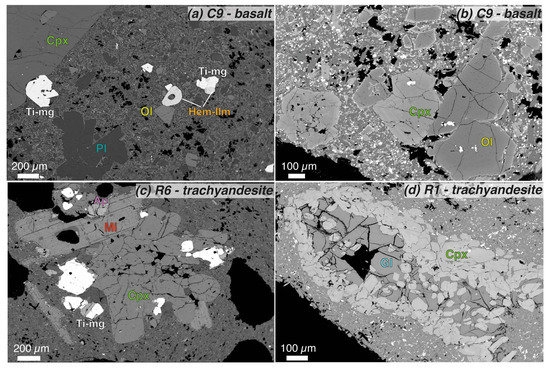
Figure 4.
Backscattered (BSE) electron images documenting microtextural features of the investigated lava samples. (a) Microphenocrysts of titano-magnetite (Ti-mg) and hema-ilmenite (Hem-Ilm) in C9 basalt. (b) Phenocrysts of olivine (Ol) and clinopyroxene (Cpx) in C9 basalt. (c) Glomerocryst of Cpx, mica (Mi), Ti-mg, and apatite (Ap) in R6 trachyandesite. (d) Small undevitrified glass (Gl) drops surrounded by a Cpx reaction rim in R1 trachyandesite.
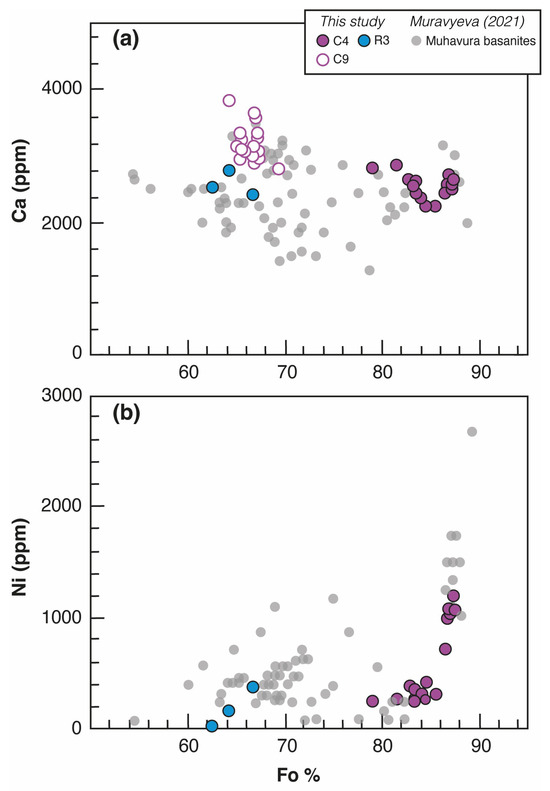
Figure 5.
(a,b) Variations of Ca (ppm) and Ni (ppm) with Fo (mol%) of olivine in the investigated lava samples. Literature data of olivine crystals hosted in two basalts from the Muhavura volcano [18] are reported for comparison.
4.2.2. Clinopyroxene
Clinopyroxene occurs in all analyzed rocks (Figure 4), displaying both normal and reverse zoning. The composition of the analyzed clinopyroxene crystals ranges from diopside to augite (Wo 42–52; En 38–42, Fs 8–25; Figure 6a), and shows chemical variations as a function of the whole rock composition.
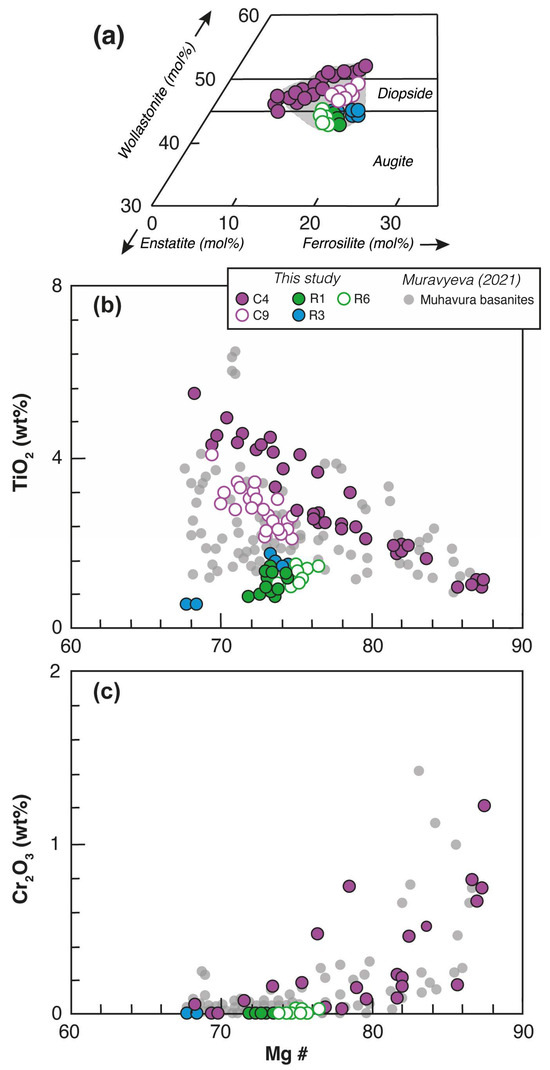
Figure 6.
Compositions of clinopyroxene hosted in the investigated lava samples. (a) Inset of wollastonite–enstatite–ferrosilite classification diagram (boundaries after [26]). (b) Mg# (mol%) versus TiO2 (wt%). (c) Mg# (mol%) versus Cr2O3 (wt%). Literature data of clinopyroxene crystals hosted in two basalts from the Muhavura volcano [18] are reported for comparison.
In the C4 basalt, clinopyroxene exhibits the largest variation in Mg# value (Mg# = 68–88; where Mg# = molar MgO/(MgO + FeOtot × 100). This variation shows a trend of increasing TiO2 (from 0.8 to 6.0 wt%) and decreasing Cr2O3 (from 1.2 wt% to values below the detection limit) with decreasing Mg# (Figure 6b). A cluster distribution is also observed at more primitive compositions (Mg# > 75) in the Cr2O3-Mg# diagram (Figure 6c), with Cr-rich zones (Cr2O3 up to 1.2 wt%) occurring at different Mg# values. Clinopyroxene in the C9 basalt exhibits a narrower Mg# range (68–76), similar to the more evolved clinopyroxene found in the C4 basalt. However, the C9 clinopyroxene crystals contain lower TiO2 concentrations, ranging from 2 to 4 wt% (Figure 6b).
In the R3 basaltic trachyandesite, only a few clinopyroxene crystals were analyzed, including a small crystal enclosed in a plagioclase phenocryst and two phenocrysts. The composition of these crystals yields a similar Mg# range to the clinopyroxene crystals from the C9 basalt, but define an array in the TiO2-Mg# diagram at lower TiO2 concentrations (0.2–2 wt%), with the most evolved (Mg# = 68) and the less evolved (Mg# = 73–74) compositions represented by the small crystal included in the plagioclase and the two phenocrysts, respectively (Figure 6b,c).
The few clinopyroxene crystals analyzed in the R1 and R6 trachyandesite fall at the less evolved end of the array defined by the R3 clinopyroxene crystals (Mg# = 72–78; Figure 6b,c). These crystals occur both as glomerocrysts in association with brown mica and titanomagnetite (Figure 4c), and as grains forming reaction rims around small undevitrified silica-rich (SiO2 = 66–69 wt%) glass droplets (Figure 4d).
4.2.3. Plagioclase
Plagioclase is present in all the analyzed rocks (Figure 3), exhibiting both normal and reverse zoning. Overall, the An content of the analyzed crystals ranges from An₅₄ to An88 (Figure 7). Plagioclase from the C9 basalt displays a negative correlation between MgO and An content, as seen by the composition plot along the equilibrium Mg-partitioning curve for plagioclase—calculated for a melt with a MgO content of 6 wt%, similar to that of the C9 basalt (MgO = 6.5 wt%), and a temperature of 1100 °C (Figure 7). In contrast, plagioclase crystals from the evolved R1 and R3 lavas define two distinct trends in the An–MgO diagram (Figure 7). Crystals from the R1 trachyandesite form an approximately horizontal array at lower MgO concentrations (around 0.06 wt%). At low An contents (~60), it intercepts the equilibrium Mg-partitioning curve for plagioclase—calculated for a melt with a MgO content of 2 wt% (similar to that of the R1 lava, MgO = 1.7 wt%) and a temperature of 1050 °C—and then slightly deviates from it as An increases, resulting in an approximately horizontal trend. Instead, the plagioclase from the less evolved R3 basaltic trachyandesite define a slightly inclined trend, progressing towards higher MgO and An contents, thereby approaching the compositional field of plagioclase from the two basalts, which, in contrast, exhibit an opposite trend.
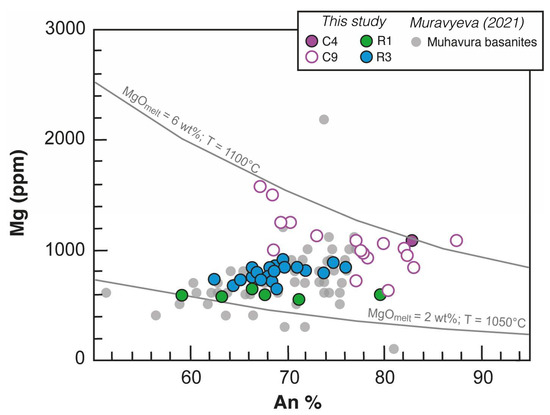
Figure 7.
An content (mol%) vs. Mg concentrations for plagioclase hosted in the investigated lava samples. Measurement uncertainties (1SD) are smaller than the symbol size. Solid lines represent Mg-plagioclase partitioning curves calculated using equations and coefficients from [27] for two melts having MgO contents and temperatures as indicated along the curve. Literature data of plagioclase crystals hosted in two basalts from the Muhavura volcano [18] are reported for comparison.
4.2.4. Mica, Leucite, Apatite and Opaque Minerals
A small number of brown mica phenocrysts, surrounded by thin, fine-grained reaction rims, were identified in the R1 and R6 trachyandesites (Figure 3f). The analyzed mica crystals lie on the phlogopite-biotite division line in the Mg-Al-Fe classification diagram ([28]; Figure S2). In terms of chemical composition, the analyzed crystals result slightly different from the phlogopites analyzed so far from other VVP volcanic products (i.e., one ultrabasic volcanic rock from Visoke volcano) [17]; exhibiting lower Mg# values (64–67), slightly lower Al2O3 (14–15 wt%), higher FeOtot (12–13 wt%), and similar high TiO2 concentrations (around 8 wt%).
Leucite is found as microphenocrysts and in the groundmass of C9 basalt, and shows almost pure composition, with K# [100 × K/(K + Na)] ranging from 97 to 99. Apatite, with a F content of 2.8–2.9 wt%, occurs as microphenocrysts occasionally enclosed within other mineral phases only in the evolved R1, R3, and R6 lavas.
Opaque minerals are mainly represented by titanomagnetite (FeOtot = 62–67 wt%; TiO2 = 18–25 wt%). These minerals occur in all analyzed samples, mostly in the groundmass and as inclusions in the phenocryst phases, but also as microphenocrysts in the R1 and R6 trachyandesites. Sample C9 also contains microphenocrysts of hema-ilmenite along with titanomagnetite (Figure 4a). Cr-spinel (Cr2O3 = 32–33 wt%) was found enclosed in olivine phenocrysts of the C4 basalt.
5. Discussion
The notable match observed between the bulk-rock geochemical features of the samples analyzed in this study and those previously recognized in the Gahinga and Muhavura lavas (Figure 2), as well as the similarity observed between the chemistry of the mineral phases (i.e., olivine, clinopyroxene, and plagioclase) hosted in the analyzed samples and in the ne-normative basalts from Muhavura volcano (Figure 5, Figure 6 and Figure 7), suggest that the whole-rock and mineral analyses of this study can be used to investigate aspects related to the magmatism of the Gahinga and Muhavura volcanoes, which belong to the eastern branch of the VVP region (Figure 1). Nevertheless, it is not possible to establish which of the studied lava samples belong to the Gahinga volcano and which to the Muhavura volcano. Therefore, in the following sections, we will treat the studied samples as a lava suite representative of eastern VVP magmatism.
In order to investigate aspects related to this magmatic activity, we estimated the pre-eruptive storage conditions of the studied lava samples and combined these data with the whole-rock compositions in thermodynamic modelling in an attempt to simulate the compositional evolution defined by the lava suite. Then, we compared our results to those obtained at the two active Nyiragongo and Nyamulagira volcanoes of the VVP [11,12], finding analogies in the storage conditions that have implications for the vision of the VVP magmatic plumbing system at the regional scale.
5.1. Pre-Eruptive Storage Conditions
The pre-eruptive P-T-H2O conditions of the studied lava samples were estimated using clinopyroxene-, olivine-, plagioclase-liquid thermobarometers and hygrometers. Whole rock compositions were used as proxies for the silicate liquids coexisting with the minerals, under the assumption of chemical equilibrium between the two [29]. Calculations were made for every mineral–liquid pairing that passed their respective evaluations of equilibrium, as described below. The complete results of the calculations are tabulated in Tables S2–S4.
Clinopyroxene–melt equilibrium was assessed using the model revised by [30], based on the early formalism introduced by [29]. This approach evaluates the difference between observed and predicted concentrations of the diopside + hedenbergite component (ΔDiHd) in clinopyroxene, where predictions are derived from regression analyses of equilibrium clinopyroxene–melt pairs. Equilibrium is considered attained when ΔDiHd < 0.10 [31].
Olivine–melt equilibrium was tested using the Fe-Mg exchange (ol-meltKDFe-Mg = 0.30 ± 0.03, calculated using FeO as only Fe2+ for the melt) of [32], which is considered to be nearly constant over a wide range of temperatures, oxygen fugacities and bulk system compositions.
Plagioclase–melt equilibrium was evaluated by comparing the measured An content of the crystals with values predicted by the model of [5], which is based on the An–Ab exchange coefficient between mineral and melt. This coefficient is defined as pl-meltKDAb-An = (XNaPlag × XAlliq × XCaliq)/(XCaPlag × XNaliq × XSiliq), where “liq” and “Plag” refer to liquid and plagioclase composition, respectively, expressed as molar fractions. Plagioclase is considered in equilibrium with the coexisting melt when pl-meltKDAb-An = 0.10 ± 0.05 for temperatures below 1050 °C, or 0.27 ± 0.11 for temperatures above 1050 °C [5].
Temperature and pressure values for equilibrium clinopyroxene–melt pairs were estimated using the model based on the machine learning algorithm from [33], which yields uncertainties of 36 °C and 210 MPa, respectively. For each of the studied lava samples, the pressure estimates define a wide range while the temperature estimates span a narrow range (Figure 8). In detail, clinopyroxene from C4 and C9 basalts records the highest temperature values (1200 °C and 1175 °C, respectively), with pressure estimates ranging from 150 to 340 MPa for C9 and from 350 to 800 MPa for C4. More evolved lava samples yielded much lower temperature and pressure values (i.e., 1100 °C and 150–300 MPa for the R3 basaltic trachyandesite; 1050 °C and 100–200 MPa for the R1 and R6 trachyandesites).
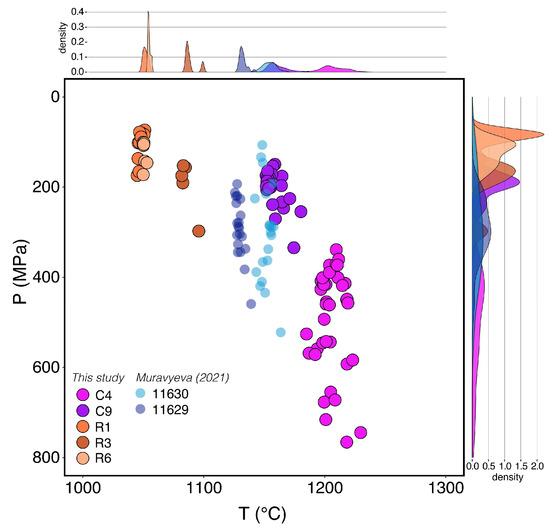
Figure 8.
Pressure vs. temperature estimates obtained using the machine-learning model from [33].
Temperature values were also estimated using equation 22 from [34] (SEE of 33 °C), based on olivine–melt pairs that passed the equilibrium test, and assuming a water content consistent with the results from the plagioclase–liquid hygrometer and thermodynamic simulations (see Section 5.2). The pressure input for the thermometric calculations was set to the average value obtained from the clinopyroxene-liquid thermobarometer for each sample. The few analyzed olivine crystals from C4 basalt and R3 basaltic trachyandesite that passed the equilibrium test recorded temperature values within the range of values estimated using clinopyroxene–melt pairs (Figure S3).
The H2O content of VVP lavas was estimated using the temperature-dependent plagioclase-liquid hygrometer of [35] (model H; with a SEE = 1.2 wt%), with input temperature values derived from clinopyroxene. The water content was estimated to be lower than 1 wt% in the C4 and C9 basalts, while values in the range of 2–4 wt% were obtained for the more evolved R1 and R3 lava samples (Table S4, Figure S4).
To further validate our thermobarometric results, the same thermobarometers and hygrometers were applied to two basanites (samples 11,629 and 11,630) from the Muhavura volcano for which the mineral chemistry is available [18]. As documented in Figure 8, Figures S3 and S4, the crystallization conditions inferred for these two lava samples (1150 °C, 200–400 MPa) fall within the range of values obtained in this study. Additionally, by applying the formulation of [36] to the coexisting Fe-Ti oxide phases in the C9 basalt, it was possible to calculate equilibrium temperature (T = 1163 ± 15 °C, in agreement with other results) and oxygen fugacity (logfO2 = −9.0 ± 0.3; ΔQFM = −0.33).
Assuming an average crustal density of 2700 kg/m3 [37], it is possible to collocate the magma storage zone at a maximum depth of 30 km for the clinopyroxene crystals hosted in the most primitive C4, while the C9 magma storage zone is likely located at a shallower level (<13 km depth). Shallower crustal levels (~4–19 km depth) are also inferred for the storage zone of the more evolved lavas (R1, R3 and R6).
5.2. Magma Evolution Paths
We use the energy-constrained thermodynamic model Magma Chamber Simulator (MCS) [6,38,39] to test whether the major element variation trends exhibited by the studied lava samples conform to a magmatic evolution scenario controlled by fractional crystallization of the phenocrysts found in these samples. Simulations were performed in fractional crystallization mode using C4 basalt as the parental melt, having a chemical composition that approaches those of primitive magmas (MgO = 8.73 wt%; Ni = 100 ppm; Cr = 400 ppm; Table S1), as well as hosting primitive olivine and clinopyroxene compositions (Figure 4 and Figure 6). Several fractional crystallization paths were simulated at different oxygen fugacities (NNO and NNO-0.5), pressures (200, 400 and 600 MPa), and initial melt-H2O contents (1 and 2 wt%). Isobaric conditions and temperature decrement steps of 10 °C were used. All input values used to run the simulations fall within the ranges of temperatures, pressures, water contents, and oxygen fugacities estimated using thermobarometric, hygrometric, and oxybarometric approaches, respectively (see Section 5.1). All data resulting from the simulations are reported in Table S7.
The best results were obtained at fO2 equivalent to NNO-0.5, in a pressure range of 200–400 MPa, and with an initial H2O content of 1 wt% in the melt (Figure 9). These results indicate that a parent C4-like basalt containing ~1 wt% H2O in a storage zone located at the mid to upper crustal depths (~8–23 km below the surface) can produce evolved basaltic trachyandesite (R3) and trachyandesite (R1, R6) compositions with solid fractionation of 50% and 70%, respectively. The solid fraction is made of Mg-olivine, clinopyroxene, and titanomagnetite at the early crystallization steps, followed by plagioclase and apatite. Mica only crystallizes once the residual melt reached trachyandesite compositions. The crystallization order of the mineral phases obtained with geochemical modelling agrees with the crystallization sequence inferred based on the inter-element correlations of the lava samples of this study and those previously studied from the Gahinga and Muhavura volcanoes [21]; these are displayed in the bivariate plots (Figure S1). As observed in these plots, the early Mg-olivine and clinopyroxene crystallization causes a decrease in the MgO and CaO content and an increase in the SiO2 content of the residual melt, while the later plagioclase crystallization produces a decrease in the Al2O3 content in the residual melt with SiO2 > 56 wt%. Mica and apatite crystallization has a negligible effect on the liquid line of descent defined by the studied lava samples, as it occurs only in the evolved lavas.
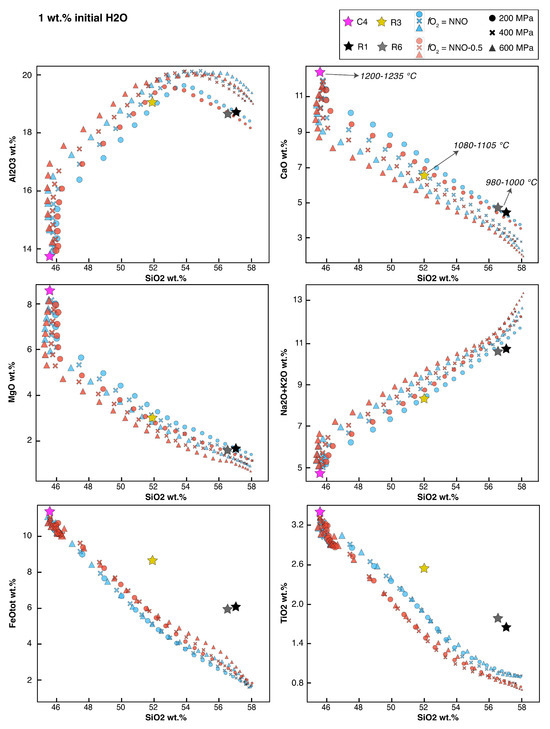
Figure 9.
Liquid line of descent calculated using Magma Chamber Simulator [6,38,39]. Only results of simulations performed with 1 wt% of initial H2O content are reported, which are found to be the best match with the composition of natural whole rocks (reported as filled stars). The arrows indicate the approximate temperature at all given points of the simulated differentiation paths.
Based on trace element and Sr-N-Pb isotopic ratios, previous studies have recognized a minor role for crustal contamination in the genesis of evolved volcanic rocks from the VVP [20,21,22]. We found small undevitrified silica-rich glass drops surrounded by a clinopyroxene reaction rim in the R1 and R6 trachyandesites (Figure 3g and Figure 4c). Similar undevitrified glass drops were identified in the basanites of the Muhavura volcano [18], further supporting the suggestion that the studied trachyandesites originated from this volcano. However, digestion of such small glass drops has a negligible effect in reconstructing the magma liquid line of descent (Figure 9), being limited to the evolved trachyandesitic melts.
5.3. Insights into the VVP Magmatic Plumbing System
The petrological evidence obtained from this study, combined with those provided by previous studies of other volcanic centers of the VVP, improves our understanding of the nature and architecture of the plumbing system beneath the VVP region.
As illustrated in Figure 10, recent petrological studies of the western active portion of the VVP identify major storage zones at depths of 22–30, 13–18, and 2–9 km beneath the Nyamulagira volcano [11], and at 9–15 and 21–33 km beneath the Nyiragongo volcano [12]. This scenario agrees with geophysical data that show a main magma storage zone located at > 10 km depth beneath both volcanoes [40,41].
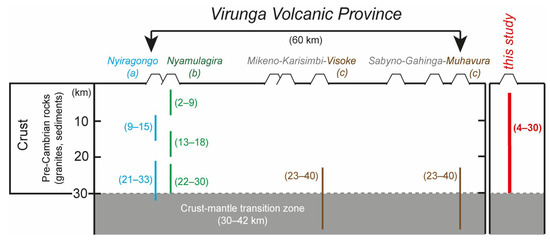
Figure 10.
Schematic illustration showing constraints on magma storage depths beneath the VVP volcanoes from previously published studies and this study. (a) Nyiragongo [12]. (b) Nyamulagira [20]. (c) Visoke and Muhavura [18]. The data provides evidence for several crystallization levels within the magmatic plumbing system under the VVP. The first level corresponds to the lower crust, where mantle-derived magmas stall and fractionate an assemblage made dominantly of olivine and clinopyroxene. Further fractionation also involving crystallization of plagioclase and feldspathoids occurred during the rise of magma toward the surface in shallower magmatic zones and led to the genesis of the evolved terms of the VVP magmatic suite. The crust–mantle transition zone beneath the VVP is from [42].
Unlike the active western sector, the eastern VVP remains poorly constrained in terms of magma storage zones and lithospheric structure. A crust–mantle transition zone was identified at a depth of 30–42 km near the Visoke volcano, historically active with its last eruption in 1957 ([18] and references therein). Magma storage conditions in the range of 23–40 km were estimated for leucite basanites from the Visoke and Muhavura volcanoes [18], the latter being the easternmost and more voluminous extinct volcano of the VVP (Figure 1). The results from this study agree with the presence of a deep magma storage region beneath the eastern VVP, also indicating the presence of magma storage zones likely distributed across mid to upper crustal levels, ranging from a 30 to 4 km depth (Figure 10).
Based on the results of this work and on those obtained in previous studies [11,12,18], a trans-crustal magmatic vision (e.g., [1]) appears plausible for the VVP plumbing system. The stalling of mantle-derived magmas within the lower crust appears to be a ubiquitous feature of this system (Figure 10). Nevertheless, previous studies of VVP magmatism have documented that the transfer toward the surface of the basic magmas could be direct, along pre-existing shear zones reactivated by the rifting processes, or multistage ([13] and references therein). Further detailed petrological studies on the lava suite from the VVP region, such as the one presented here, are necessary to offer a more complete model for the plumbing system that lies beneath this volcanic region, contributing to a better understanding of its magmatic evolutionary pathways.
6. Conclusions
This study reports the petrological and geochemical characteristics of five lava samples from the eastern VVP province that represent a suite of potassic basalts and more evolved derivatives (i.e., basaltic trachyandesites and trachyandesites). Geothermobarometric analysis indicates the occurrence of magma storage zones distributed at depths ranging from 23 to 8 km that fed these volcanoes. Based on the results of thermodynamic modelling, the basalt-trachyte evolutionary suite defined by the studied lava samples can be explained by polybaric fractionation that occurred at the inferred pre-eruptive depths and involved a mineral assemblage that varied with the chemical evolution of the melt from an olivine-clinopyroxene-dominated to a plagioclase-dominated assemblage.
Polybaric fractionation scenarios were inferred at the active volcanoes of the VVP, suggesting that differentiation of mantle-derived magmas in this volcanic region occurred in a trans-crustal plumbing system. It is expected that further studies on volcanic samples covering the chemical diversity existing at the eastern VVP volcanoes will improve our knowledge of the magmatic paths responsible for the genesis of the observed magma’s compositional diversity.
Supplementary Materials
The following supporting information can be downloaded at: https://www.mdpi.com/article/10.3390/min15070666/s1. Supplementary material.docx (Figure S1: Whole-rock major and trace element bivariant plots; Figure S2: Mica classification ternary plot; Figure S3: Fo% vs. T for olivine crystals; Figure S4: H2O vs. An% for plagioclase crystals). Electronic appendix.xlsx (Table S1: Bulk rock analysis; Table S1 (QC): Analytical precision and accuracy; Table S2: Olivine analysis; Table S3: Clinopyroxene analysis; Table S4: Plagioclase analysis; Table S5: Leucite, Mica, Glass and Apatite analysis; Table S6: Oxide analysis; Table S7: MCS simulations results; Table S8: EPMA analyses of mineral standards.
Author Contributions
Conceptualization and writing—original draft preparation, F.C. and T.T.; methodology, validation, formal analysis, data curation, data investigation, writing—review and editing, and supervision, F.C., T.T. and M.D.; software, F.C., M.D. and S.G.; resources, T.T. and R.V.; visualization, F.C., T.T. and S.G.; project administration, T.T. and R.V. All authors have read and agreed to the published version of the manuscript.
Funding
This research was supported by Fondi Ricerca Scientifica Locale di Ateneo, University of Parma (funding code: TRUA_T_FIL; VALENTINO_T_FIL).
Data Availability Statement
The original contributions presented in this study are included in the article/Supplementary Materials. Further inquiries can be directed to the corresponding author.
Acknowledgments
The authors are grateful to the anonymous reviewers and editor for their constructive comments, which contributed to the improvement of this paper. We also thank A. Comelli (University of Parma) for the preparation of the thin sections. This study has benefited from the equipment and framework of the COMP-HUB and COMP-R Initiatives, funded by the ‘Departments of Excellence’ program of the Italian Ministry for University and Research (MIUR, 2018–2022 and MIUR, 2023–2027).
Conflicts of Interest
The authors declare no conflicts of interest.
References
- Cashman, K.V.; Sparks, R.S.J.; Blundy, J.D. Vertically extensive and unstable magmatic systems: A unified view of igneous processes. Science 2017, 355, 6331. [Google Scholar] [CrossRef] [PubMed]
- Edmonds, M.; Cashman, K.V.; Holness, M.; Jackson, M. Architecture and dynamics of magma reservoirs. Phil. Trans. R. Soc. A 2019, 377, 20180298. [Google Scholar] [CrossRef] [PubMed]
- Jerram, D.A.; Dobson, K.J.; Morgan, D.J.; Pankhurst, M.J. The petrogenesis of magmatic systems: Using igneous textures to understand magmatic processes. In Volcanic and Igneous Plumbing Systems; Elsevier: Amsterdam, The Netherlands, 2018; pp. 191–229. [Google Scholar]
- Masotta, M.; Mollo, S.; Freda, C.; Gaeta, M.; Moore, G. Clinopyroxene–liquid thermometers and barometers specific to alkaline differentiated magmas. Contrib. Mineral. Petrol. 2013, 166, 1545–1561. [Google Scholar] [CrossRef]
- Putirka, K.D. Thermometers and barometers for volcanic systems. Rev. Miner. Geochem. 2008, 69, 61–120. [Google Scholar] [CrossRef]
- Bohrson, W.A.; Spera, F.J.; Heinonen, J.S.; Brown, G.A.; Scruggs, M.A.; Adams, J.V.; Takach, M.K.; Zeff, G.; Suikkanen, E. Diagnosing open-system magmatic processes using the Magma Chamber Simulator (MCS): Part I-major elements and phase equilibria. Contrib. Miner. Petrol. 2020, 175, 105. [Google Scholar] [CrossRef]
- Gualda, G.A.; Ghiorso, M.S.; Lemons, R.V.; Carley, T.L. Rhyolite-MELTS: A modified calibration of MELTS optimized for silica-rich, fluid-bearing magmatic systems. J. Petrol. 2012, 53, 875–890. [Google Scholar] [CrossRef]
- Colle, F.; Masotta, M.; Costa, S.; Giacomoni, P.P.; Trua, T.; Marani, M. A micro-scale insight into a back-arc trans-crustal plumbing system: The case of Marsili volcano, Southern Tyrrhenian Sea. Lithos 2024, 482–483, 107675. [Google Scholar] [CrossRef]
- Colle, F.; Masotta, M.; Costa, S.; Mollo, S.; Landi, P.; Pontesilli, A.; Peres, S.; Mancini, L. Effect of undercooling on clinopyroxene crystallization in high K basalt: Implications for magma dynamics at Stromboli volcano. Lithos 2023, 456–457, 107327. [Google Scholar] [CrossRef]
- Costa, S.; Masotta, M.; Gioncada, A.; Pistolesi, M. A crystal mush perspective explains magma variability at La Fossa Volcano (Vulcano, Italy). Minerals 2021, 11, 1094. [Google Scholar] [CrossRef]
- Kamate Kaleghetso, E.; Namur, O.; Smets, B.; Vander Auwera, J.; Lubala, F.; Van Gerve, T.; Molendijk, S.M. Magmatic differentiation and plumbing system beneath Nyamulagira volcano (Virunga Volcanic Province, East African Rift). J. Volc. Geoth. Res. 2025, 458, 108264. [Google Scholar] [CrossRef]
- Molendijk, S.; Namur, O.; Kamate Kaleghetso, E.; Mason, P.R.D.; Smets, B.; Vander Auwera, J.; Neave, D.A. Plumbing system architecture and differentiation processes of the Nyiragongo Volcano, DR Congo. J. Petrol. 2024, 65, egad088. [Google Scholar] [CrossRef]
- Barette, F.; Poppe, S.; Smets, B.; Benbakkar, M.; Kervyn, M. Spatial variation of volcanic rock geochemistry in the Virunga Volcanic Province: Statistical analysis of an integrated database. J. Afr. Earth Sci. 2017, 134, 888–903. [Google Scholar] [CrossRef]
- Chakrabarti, R.; Basu, A.R.; Santo, A.P.; Tedesco, D.; Vaselli, O. Isotopic and geochemical evidence for a heterogeneous mantle plume origin of the Virunga volcanics, Western rift, East African Rift system. Chem. Geol. 2009, 259, 273e289. [Google Scholar] [CrossRef]
- Innocenzi, F.; Ronca, S.; Foley, S.; Agostini, S.; Lustrino, M. Carbonatite and ultrabasic magmatism at Toro Ankole and Virunga, western branch of the East African Rift system. Gondwana Res. 2024, 125, 317–342. [Google Scholar] [CrossRef]
- Minissale, S.; Casalini, M.; Cucciniello, C.; Balagizi, C.; Tedesco, D.; Boudoire, G.; Morra, V.; Melluso, L. The geochemistry of recent Nyamulagira and Nyiragongo potassic lavas, Virunga Volcanic Province, and implications on the enrichment processes in the mantle lithosphere of the Tanzania-Congo craton. Lithos 2022, 420–421, 106696. [Google Scholar] [CrossRef]
- Muravyeva, N.S.; Belyatsky, B.V.; Senis, V.G.; Ivanov, A.V. Sr–Nd–Pb isotope systematics and clinopyroxene-host disequilibrium in ultra-potassic magmas from Toro Ankole and Virunga, East-African Rift: Implications for magma mixing and source heterogeneity. Lithos 2014, 210–211, 260–277. [Google Scholar] [CrossRef]
- Muravyeva, N.S.; Senin, V.G.; Ivanov, A.V.; Belyatsky, B.V. Leucite basanites of Virunga (East African Rift): Some insights into petrogenesis and source composition. Lithos 2021, 384–385, 105972. [Google Scholar] [CrossRef]
- Pitcavage, E.; Furman, T.; Nelson, W.; Kalegga, P.K.; Barifaijo, E. Petrogenesis of primitive lavas from the Toro Ankole and Virunga Volcanic Provinces: Metasomatic mineralogy beneath East Africa’s Western Rift. Lithos 2021, 396–397, 106192. [Google Scholar] [CrossRef]
- Rogers, N.W.; De Mulder, M.; Hawkesworth, C.J. An enriched mantle source for potassic basanites: Evidence from Karisimbi volcano, Virunga volcanic province, Rwanda. Contrib. Mineral. Petrol. 1992, 111, 543–556. [Google Scholar] [CrossRef]
- Rogers, N.W.; James, D.; Kelley, S.P.; De Mulder, M. The generation of potassic lavas from the Eastern Virunga Province, Rwanda. J. Petrol. 1998, 39, 1223–1247. [Google Scholar] [CrossRef]
- De Mulder, M.; Hertogen, J.; Deutsch, S.; Andre, L. The role of crustal contamination in the potassic suite of the Karisimbi volcano (Virunga, African Rift Valley). Chem. Geol. 1986, 57, 117e136. [Google Scholar] [CrossRef]
- Armstrong, J.T. Quantitative elemental analysis of individual microparticles with electron beam instruments. In Electron Probe Quantitation; Springer: New York, NY, USA, 1991; pp. 261–315. [Google Scholar]
- Le Maitre, R.W. Classification of Igneous Rocks and Glossary of Terms. Recommendations of the IUGS Subcommission on the Systematics of Igneous Rocks; Cambridge University Press: Cambridge, UK, 2002. [Google Scholar]
- McDonough, W.F.; Sun, S.-S. The composition of the Earth. Chem. Geol. 1995, 120, 223–253. [Google Scholar] [CrossRef]
- Morimoto, N. Nomenclature of pyroxene. Can. Mineral. 1988, 27, 143–156. [Google Scholar]
- Bindeman, I.; Davis, A.; Drake, M. Ion microprobe study of plagioclase–basalt partition experiments at natural concentration levels of trace elements. Geochim. Cosmochim Acta 1998, 62, 1175–1193. [Google Scholar] [CrossRef]
- Li, X.; Zhang, C.; Behrens, H.; Holtz, F. Calculating biotite formula from electron microprobe analysis data using a machine learning method based on principal components regression. Lithos 2020, 356–357, 105371. [Google Scholar] [CrossRef]
- Putirka, K.; Johnson, M.; Kinzler, R.; Longhi, J.; Walker, D. Thermobarometry of mafic igneous rocks based on clinopyroxene-liquid equilibria, 0–30 kbar. Contrib. Mineral. Petrol. 1996, 123, 92–108. [Google Scholar] [CrossRef]
- Mollo, S.; Putirka, K.; Misiti, V.; Soligo, M.; Scarlato, P. A new test for equilibrium based on clinopyroxene–melt pairs: Clues on the solidification temperatures of Etnean alkaline melts at post-eruptive conditions. Chem. Geol. 2013, 352, 92–100. [Google Scholar] [CrossRef]
- Mollo, S.; Masotta, M. Optimizing pre-eruptive temperature estimates in thermally and chemically zoned magma chambers. Chem. Geol. 2014, 368, 97–103. [Google Scholar] [CrossRef]
- Roeder, P.L.; Emslie, R.F. Olivine-liquid equilibrium. Contrib. Mineral. Petrol. 1970, 29, 275–289. [Google Scholar] [CrossRef]
- Ágreda-López, M.; Parodi, V.; Musu, A.; Jorgenson, C.; Carfì, A.; Mastrogiovanni, F.; Caricchi, L.; Perugini, D.; Petrelli, M. Enhancing machine learning thermobarometry for clinopyroxene-bearing magmas. Comput. Geosci. 2024, 193, 105707. [Google Scholar] [CrossRef]
- Putirka, K.D.; Perfit, M.; Ryerson, F.; Jackson, M.G. Ambient and excess mantle temperatures, olivine thermometry, and active vs. passive upwelling. Chem. Geol. 2007, 241, 177–206. [Google Scholar] [CrossRef]
- Putirka, K.D. Igneous thermometers and barometers based on plagioclase+ liquid equilibria: Tests of some existing models and new calibrations. Am. Mineral. 2005, 90, 336–346. [Google Scholar] [CrossRef]
- Andersen, D.J.; Lindsley, D.H. New (and final) models for the Ti-magnetite/ilmenite geothermometer and oxygen barometer. Am Geophys. Union 1985, 66, 416. [Google Scholar]
- Pinel, V.; Mériaux, C. Subsurface lateral magma propagation from Nyiragongo volcano in the Western Rift Zone of the East African Rift. J. Afr. Earth Sci. 2025, 226, 105569. [Google Scholar] [CrossRef]
- Bohrson, W.A.; Spera, F.J.; Ghiorso, M.S.; Brown, G.A.; Creamer, J.B.; Mayfield, A. Thermodynamic model for energy-constrained open-system evolution of crustal magma bodies undergoing simultaneous recharge, assimilation and crystallization: The magma chamber simulator. J. Petrol. 2014, 55, 1685–1717. [Google Scholar] [CrossRef]
- Heinonen, J.S.; Iles, K.A.; Heinonen, A.; Fred, R.; Virtanen, V.J.; Bohrson, W.A.; Spera, F.J. From Binary mixing to magma chamber simulator: Geochemical modeling of assimilation in magmatic systems. In Crustal Magmatic System Evolution: Anatomy, Architecture, and Physico-Chemical Processes; American Geophysical Union: Washington, DC, USA, 2021; Volume 7, pp. 151–176. [Google Scholar]
- Ji, K.H.; Stamps, D.S.; Geirsson, H.; Mashagiro, N.; Syauswa, M.; Kafudu, B.; Subira, J.; D’Oreye, N. Deep magma accumulation at Nyamulagira volcano in 2011 detected by GNSS observations. J. Afr. Earth Sci. 2017, 134, 824–830. [Google Scholar] [CrossRef]
- Wauthier, C.; Cayol, V.; Poland, M.; d’Oreye, F.N.; Hooper, A.; Samsonov, S.; Tiampo, K.; Smets, B. Nyamulagira’s magma plumbing system inferred from 15 years of InSAR. Geol. Soc. Lond. Spec. Publ. 2013, 380, 39–65. [Google Scholar] [CrossRef]
- Tuluka, G.M. Crustal structure beneath two seismic broadband stations revealed from teleseismic P-wave receiver function. J. Afr. Earth Sci. 2010, 58, 820–828. [Google Scholar] [CrossRef]
Disclaimer/Publisher’s Note: The statements, opinions and data contained in all publications are solely those of the individual author(s) and contributor(s) and not of MDPI and/or the editor(s). MDPI and/or the editor(s) disclaim responsibility for any injury to people or property resulting from any ideas, methods, instructions or products referred to in the content. |
© 2025 by the authors. Licensee MDPI, Basel, Switzerland. This article is an open access article distributed under the terms and conditions of the Creative Commons Attribution (CC BY) license (https://creativecommons.org/licenses/by/4.0/).